Abstract
Plasmid DNA-mediated transformation of vegetative cells of Bacillus thuringiensis was studied with the following two plasmids: pBC16 coding for tetracycline resistance and pC194 expressing chloramphenicol resistance. A key step was the induction of competence by treatment of the bacteria with 50 mM Tris hydrochloride buffer (pH 8.9) containing 30% sucrose. Transformation frequency was strongly influenced by culture density during the uptake of DNA and required the presence of polyethylene glycol. Growth in a minimal medium supplemented with Casamino Acids gave 35 times more transformants than growth in a rich medium. The highest frequencies were obtained with covalently closed circular DNA. With all parameters optimized, the frequency was 10(-3) transformants per viable cell or 10(4) transformants per microgram of DNA. Cells previously frozen were also used as recipients in transformation experiments; such cells gave frequencies similar to those obtained with freshly grown cells. The procedure was optimized for B. thuringiensis subsp. gelechiae, but B. thuringiensis subsp. kurstaki, B. thuringiensis subsp. galleriae, B. thuringiensis subsp. thuringiensis, and B. thuringiensis subsp. israelensis were also transformed. Compared with protoplast transformation, our method is much faster and 3 orders of magnitude more efficient per microgram of added DNA.
Full text
PDF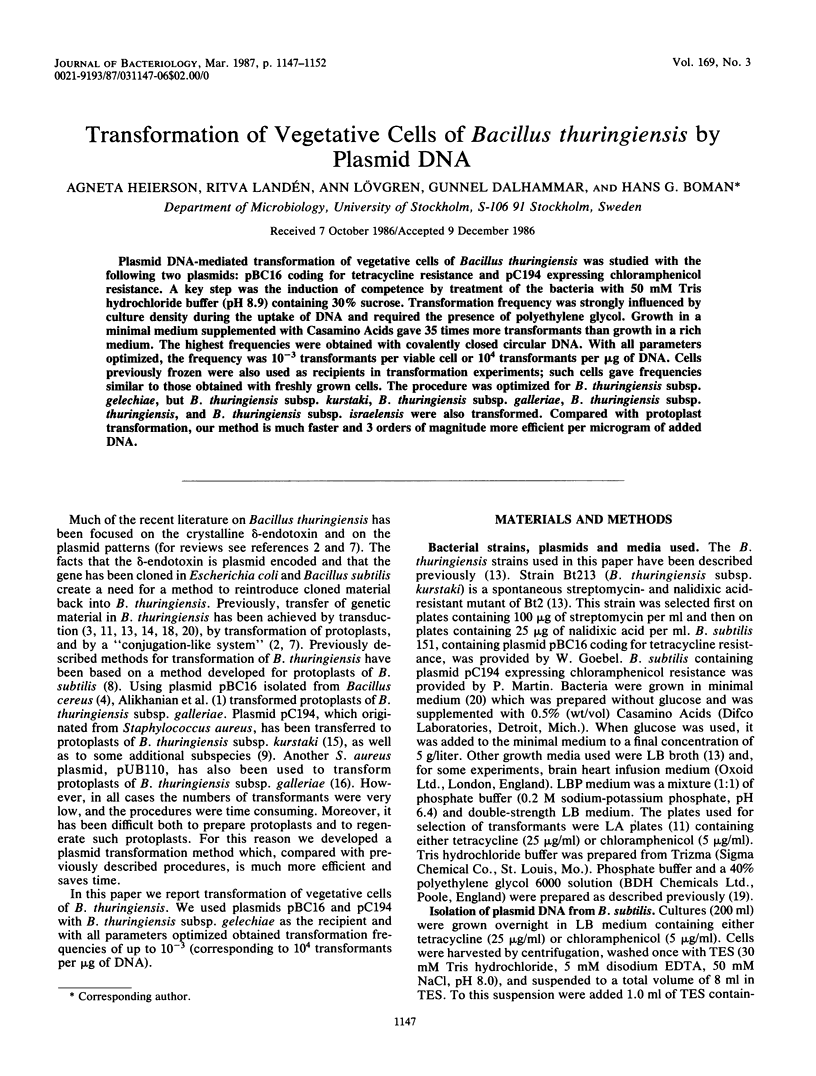
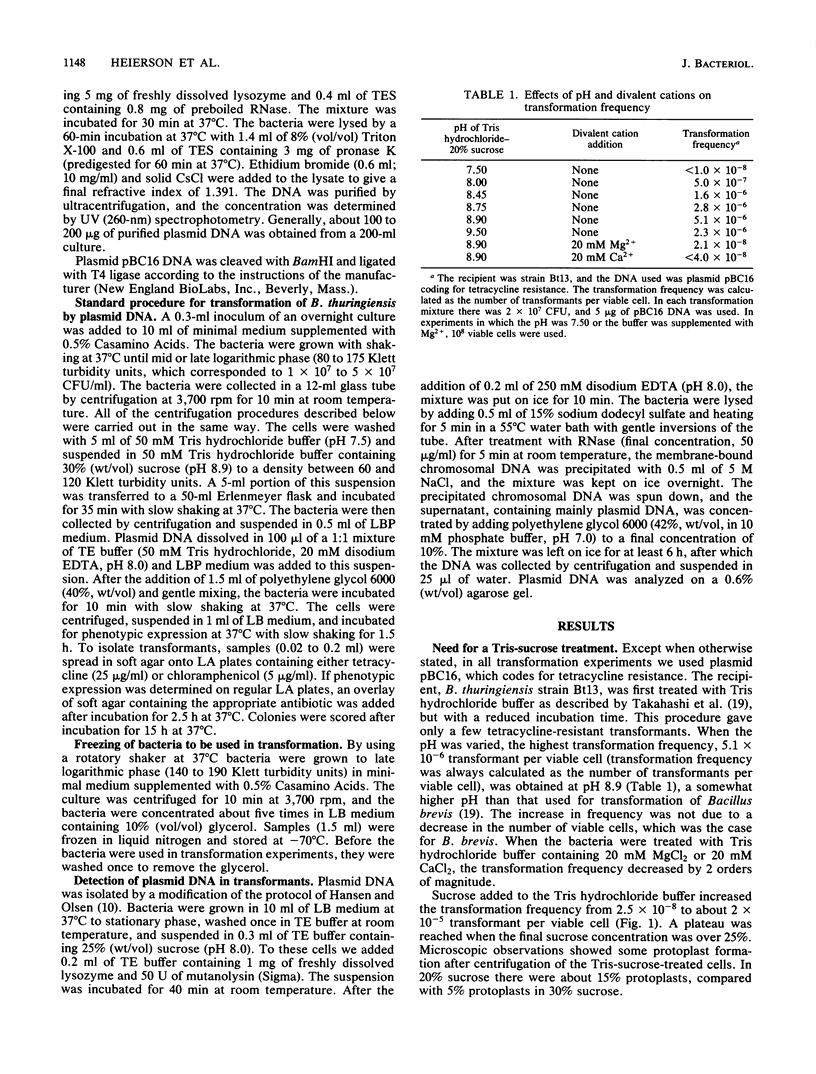
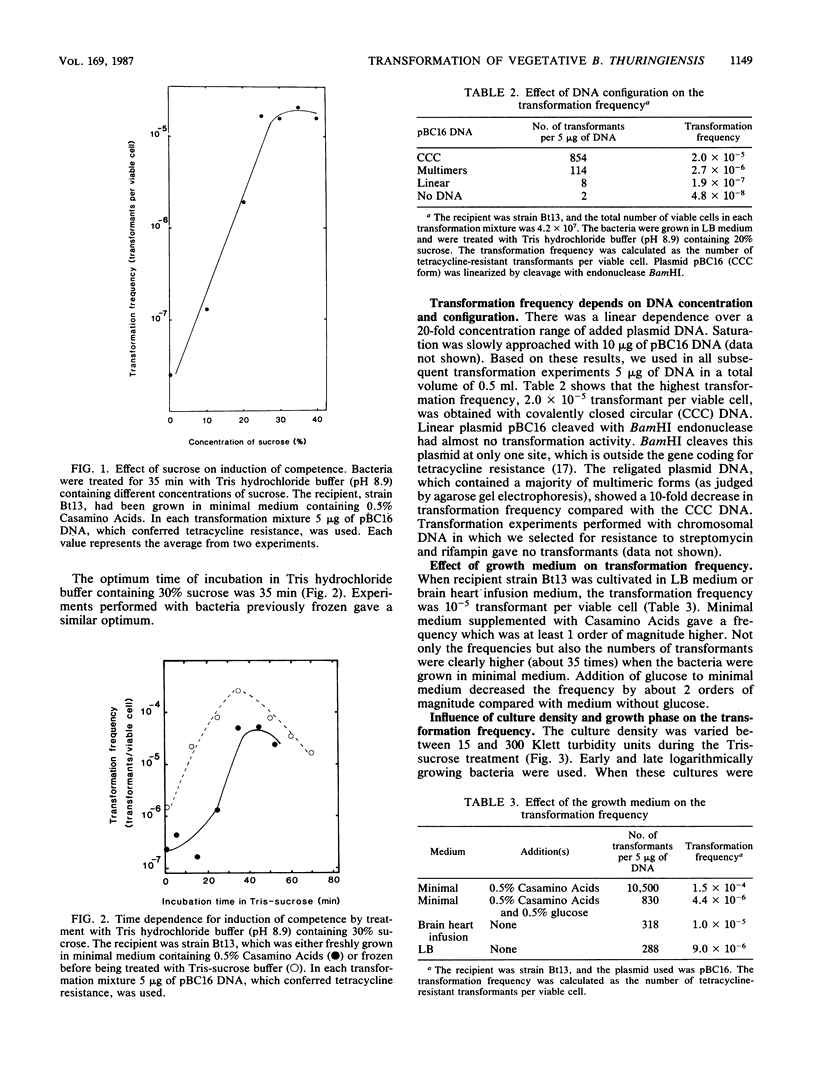
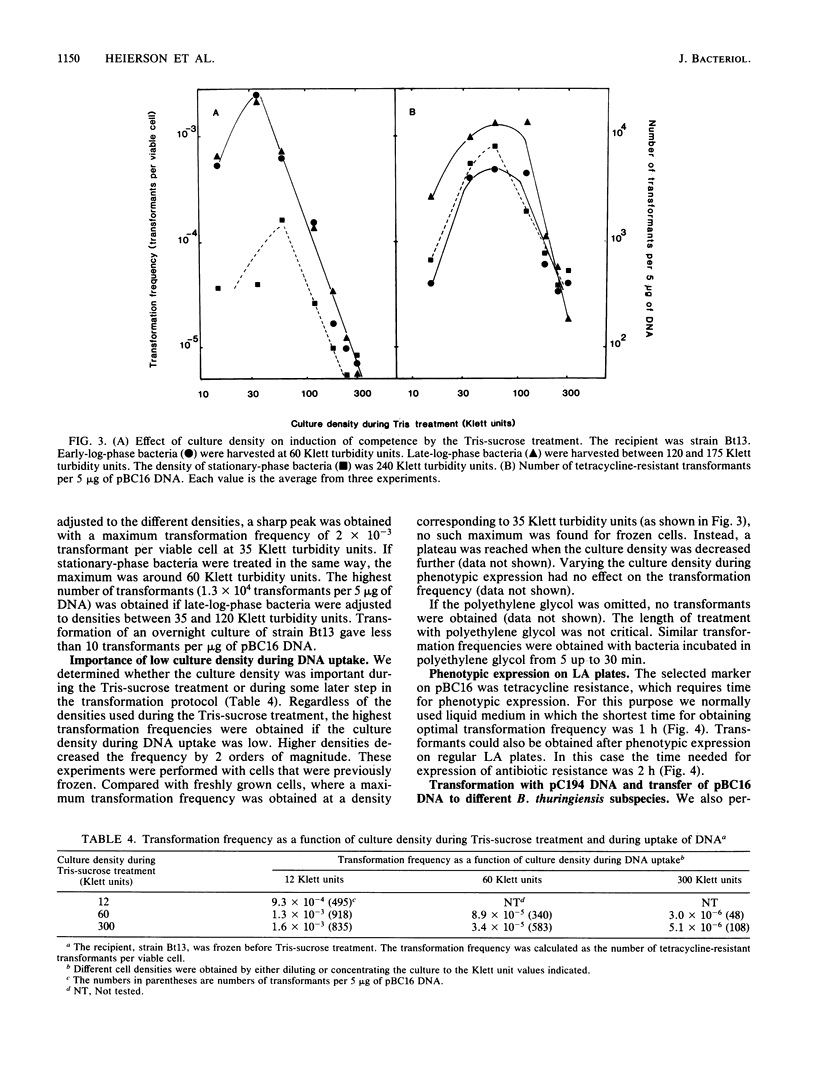
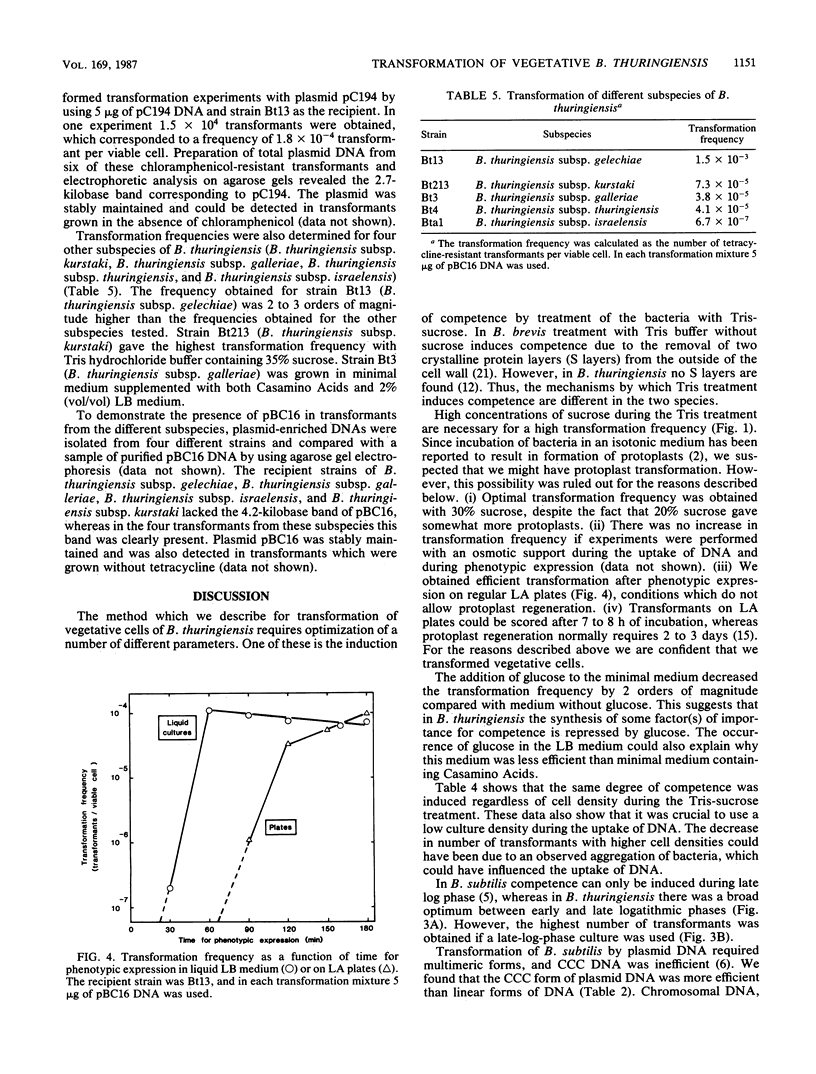
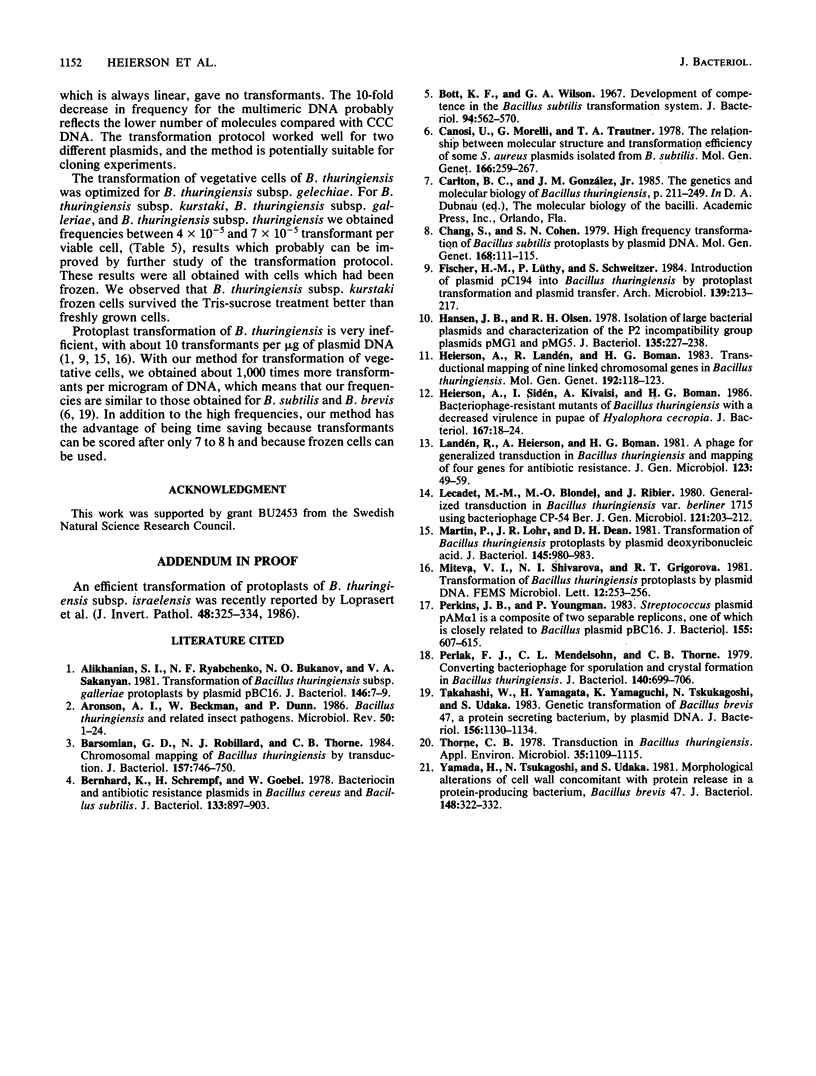
Selected References
These references are in PubMed. This may not be the complete list of references from this article.
- Alikhanian S. I., Ryabchenko N. F., Bukanov N. O., Sakanyan V. A. Transformation of Bacillus thuringiensis subsp. galleria protoplasts by plasmid pBC16. J Bacteriol. 1981 Apr;146(1):7–9. doi: 10.1128/jb.146.1.7-9.1981. [DOI] [PMC free article] [PubMed] [Google Scholar]
- Aronson A. I., Beckman W., Dunn P. Bacillus thuringiensis and related insect pathogens. Microbiol Rev. 1986 Mar;50(1):1–24. doi: 10.1128/mr.50.1.1-24.1986. [DOI] [PMC free article] [PubMed] [Google Scholar]
- Barsomian G. D., Robillard N. J., Thorne C. B. Chromosomal mapping of Bacillus thuringiensis by transduction. J Bacteriol. 1984 Mar;157(3):746–750. doi: 10.1128/jb.157.3.746-750.1984. [DOI] [PMC free article] [PubMed] [Google Scholar]
- Bernhard K., Schrempf H., Goebel W. Bacteriocin and antibiotic resistance plasmids in Bacillus cereus and Bacillus subtilis. J Bacteriol. 1978 Feb;133(2):897–903. doi: 10.1128/jb.133.2.897-903.1978. [DOI] [PMC free article] [PubMed] [Google Scholar]
- Bott K. F., Wilson G. A. Development of competence in the Bacillus subtilis transformation system. J Bacteriol. 1967 Sep;94(3):562–570. doi: 10.1128/jb.94.3.562-570.1967. [DOI] [PMC free article] [PubMed] [Google Scholar]
- Canosi U., Morelli G., Trautner T. A. The relationship between molecular structure and transformation efficiency of some S. aureus plasmids isolated from B. subtilis. Mol Gen Genet. 1978 Nov 9;166(3):259–267. doi: 10.1007/BF00267617. [DOI] [PubMed] [Google Scholar]
- Chang S., Cohen S. N. High frequency transformation of Bacillus subtilis protoplasts by plasmid DNA. Mol Gen Genet. 1979 Jan 5;168(1):111–115. doi: 10.1007/BF00267940. [DOI] [PubMed] [Google Scholar]
- Fischer H. M., Lüthy P., Schweitzer S. Introduction of plasmid pC194 into Bacillus thuringiensis by protoplast transformation and plasmid transfer. Arch Microbiol. 1984 Oct;139(2-3):213–217. doi: 10.1007/BF00402002. [DOI] [PubMed] [Google Scholar]
- Hansen J. B., Olsen R. H. Isolation of large bacterial plasmids and characterization of the P2 incompatibility group plasmids pMG1 and pMG5. J Bacteriol. 1978 Jul;135(1):227–238. doi: 10.1128/jb.135.1.227-238.1978. [DOI] [PMC free article] [PubMed] [Google Scholar]
- Heierson A., Sidén I., Kivaisi A., Boman H. G. Bacteriophage-resistant mutants of Bacillus thuringiensis with decreased virulence in pupae of Hyalophora cecropia. J Bacteriol. 1986 Jul;167(1):18–24. doi: 10.1128/jb.167.1.18-24.1986. [DOI] [PMC free article] [PubMed] [Google Scholar]
- Lecadet M. M., Blondel M. O., Ribier J. Generalized transduction in Bacillus thuringiensis var. berliner 1715 using bacteriophage CP-54Ber. J Gen Microbiol. 1980 Nov;121(1):203–212. doi: 10.1099/00221287-121-1-203. [DOI] [PubMed] [Google Scholar]
- Martin P. A., Lohr J. R., Dean D. H. Transformation of Bacillus thuringiensis protoplasts by plasmid deoxyribonucleic acid. J Bacteriol. 1981 Feb;145(2):980–983. doi: 10.1128/jb.145.2.980-983.1981. [DOI] [PMC free article] [PubMed] [Google Scholar]
- Perkins J. B., Youngman P. Streptococcus plasmid pAM alpha 1 is a composite of two separable replicons, one of which is closely related to Bacillus plasmid pBC16. J Bacteriol. 1983 Aug;155(2):607–615. doi: 10.1128/jb.155.2.607-615.1983. [DOI] [PMC free article] [PubMed] [Google Scholar]
- Perlak F. J., Mendelsohn C. L., Thorne C. B. Converting bacteriophage for sporulation and crystal formation in Bacillus thuringiensis. J Bacteriol. 1979 Nov;140(2):699–706. doi: 10.1128/jb.140.2.699-706.1979. [DOI] [PMC free article] [PubMed] [Google Scholar]
- Takahashi W., Yamagata H., Yamaguchi K., Tsukagoshi N., Udaka S. Genetic transformation of Bacillus brevis 47, a protein-secreting bacterium, by plasmid DNA. J Bacteriol. 1983 Dec;156(3):1130–1134. doi: 10.1128/jb.156.3.1130-1134.1983. [DOI] [PMC free article] [PubMed] [Google Scholar]
- Thorne C. B. Transduction in Bacillus thuringiensis. Appl Environ Microbiol. 1978 Jun;35(6):1109–1115. doi: 10.1128/aem.35.6.1109-1115.1978. [DOI] [PMC free article] [PubMed] [Google Scholar]
- Yamada H., Tsukagoshi N., Udaka S. Morphological alterations of cell wall concomitant with protein release in a protein-producing bacterium, Bacillus brevis 47. J Bacteriol. 1981 Oct;148(1):322–332. doi: 10.1128/jb.148.1.322-332.1981. [DOI] [PMC free article] [PubMed] [Google Scholar]


